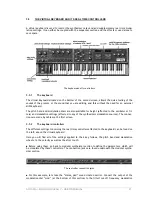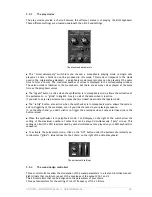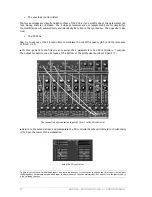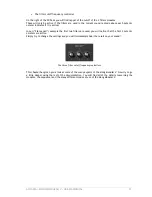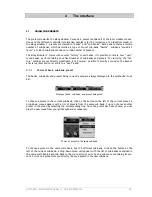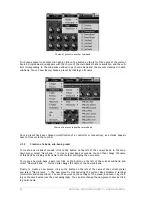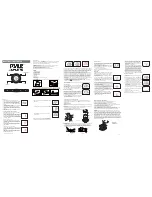
ARTURIA – MOOG MODULAR V – USER’S MANUAL
61
4.4 USING
CABLES
The connection of different modules is the base work of creating a new patch. The Moog Modular V
owes its creative possibilities in no small part to the innumerable connections possible between mo-
dules. On the original system, all of the connections were made with cables of two types:
Audio and modulation cables (which allow for example the connection of an oscillator sawtooth sig-
nal to a filter input).
The trigger cables (which allow for example the connection of the keyboard to auxiliary envelopes).
The trigger cables transport trigger information for envelopes or the sequencer for example.
In the Moog Modular V, for ergonomics and graphical readability, only part of the connections is dis-
played on the screen in cable form. The other connections are made either by menus, or with digi-
tal displays on which we can click.
The different types of connections we can use on the Moog Modular V are as follows:
Audio connections / modulation connections: these connections are made with cables that are visi-
ble on the screen.
Trigger connections: these connections are only done through menus.
Synchronization connections: these connections are only done through menus.
Key follow or sequencer connections: these connections are available and can be modified through
visible digital displays on the filters and drivers modules.
4.4.1
Audio and modulation connections
The audio connections allow, for example, the routing of a sound to the VCA/mixers or to the inputs
of different filters. The modulation connections allow, for example, routing of an LFO output or an
envelope generator to an oscillator PWM or VCA modulation input. These audio and modulation sig-
nals are totally compatible, the only difference being that the audio signals are “audible” if you
connect them directly to an output VCA, while the modulation signals are generally not audible (as
the frequency is too low for the human ear). Modulation signals are thus generally used to program
“slow” variations on certain synthesis parameters, like the cut-off frequency of a filter for example.
The audio output and input connectors, and the modulation output connectors are identical in the
graphical interface:
Audio input or output connectors, or modulation output connectors
The modulation input connectors are graphically distinguished from the other connectors as they
include an extra function: a modulation level setting, described later in this paragraph:
Modulation input connectors
To connect a modules output to the input of another module, click on the output and drag it to the
target input while holding down the mouse button. When you are above the input, the connector
lights. In this case, you just need to release the mouse button to link a cable between the selected
output and input.
Содержание Moog Modular V
Страница 1: ...USER S MANUAL Moog Modular V 2 ...
Страница 4: ......
Страница 8: ......
Страница 18: ...18 ARTURIA MOOG MODULAR V USER S MANUAL ...
Страница 52: ...52 ARTURIA MOOG MODULAR V USER S MANUAL ...
Страница 85: ...ARTURIA MOOG MODULAR V USER S MANUAL 85 Independent mode Parallel mode Serial mode ...
Страница 102: ...102 ARTURIA MOOG MODULAR V USER S MANUAL ...
Страница 144: ...144 ARTURIA MOOG MODULAR V USER S MANUAL ...

